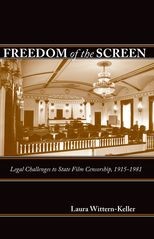Freedom of the Screen: Legal Challenges to State Film Censorship, 1915-1981
Freedom of the Screen: Legal Challenges to State Film Censorship, 1915-1981
Cite
Abstract
The proliferation of movies at the turn of the twentieth century attracted not only the attention of audiences across America, but also the apprehensive eyes of government officials and special interest groups concerned about the messages which the movies disseminated. Between 1907 and 1926, seven states and more than 100 cities authorized censors to suppress all images and messages considered inappropriate for American audiences. Movie studios, hoping to avoid problems with state censors, worrying that censorship might be extended to the federal level, and facing increased pressure from religious groups, also jumped into the censoring business. They restrained the content by adopting the self-censoring Production Code, also known as the Hays code. Some industry outsiders, however, believed that movies deserved the free speech protections of the First Amendment and brought legal challenges to censorship at the state and local levels. This book chronicles both the evolution of judicial attitudes toward film restriction, and the plight of the individuals who fought for the right to deliver provocative and relevant movies to American audiences. The path to cinematic freedom was marked with both achievements and roadblocks, which are discussed in detail. The book's coverage extends from the establishment of the Production Code Administration, to the landmark cases over films such as The Miracle, La ronde, and Lady Chatterley's Lover which paved the way for increased freedom of expression. As the fight against censorship progressed case by case through state courts and the U.S. Supreme Court, legal authorities and the public responded, growing increasingly sympathetic toward artistic freedom. A small, unorganized group of independent film distributors and exhibitors during the middle of the twentieth-century fought back against what they believed was an unconstitutional prior restraint of motion pictures. This effectively gave films after 1965 a new direction and allowed movies to mature into an artistic medium.
-
Front Matter
-
Introduction
-
1
The Origins of Governmental Film Censorship, 1907–1923
-
2
The Courts Provide No Relief, 1909–1927
-
3
Hollywood and the Legion of Decency, 1922–1934
-
4
Early Challenges to State Censors, 1927–1940
-
5
The First Amendment Resurfaces, 1946–1950
-
6
The Strange Case of The Miracle, 1950–1952
-
7
La Ronde, 1951–1954
-
8
The Tide Turns against the Censors, 1953–1957
-
9
The Seventh Case in Seven Years, 1957–1959
-
10
The Curtain Coming Down, 1957–1964
-
11
Fight for Freedom of the Screen, 1962–1965
-
12
Denouement, 1965–1981
- Conclusion
-
End Matter
Sign in
Personal account
- Sign in with email/username & password
- Get email alerts
- Save searches
- Purchase content
- Activate your purchase/trial code
Institutional access
-
Sign in through your institution
- Sign in with a library card Sign in with username/password Recommend to your librarian
Institutional account management
Sign in as administratorPurchase
Our books are available by subscription or purchase to libraries and institutions.
Purchasing information| Month: | Total Views: |
|---|---|
| December 2022 | 1 |
| March 2023 | 1 |
| March 2023 | 2 |
| April 2023 | 1 |
| April 2023 | 2 |
| April 2023 | 1 |
| April 2023 | 1 |
| April 2023 | 1 |
| November 2023 | 1 |
| December 2023 | 1 |
| December 2023 | 3 |
| December 2023 | 3 |
| December 2023 | 5 |
| December 2023 | 1 |
| December 2023 | 1 |
| December 2023 | 1 |
| December 2023 | 1 |
| February 2024 | 2 |
| February 2024 | 2 |



Get help with access
Institutional access
Access to content on Oxford Academic is often provided through institutional subscriptions and purchases. If you are a member of an institution with an active account, you may be able to access content in one of the following ways:
IP based access
Typically, access is provided across an institutional network to a range of IP addresses. This authentication occurs automatically, and it is not possible to sign out of an IP authenticated account.
Sign in through your institution
Choose this option to get remote access when outside your institution. Shibboleth/Open Athens technology is used to provide single sign-on between your institution’s website and Oxford Academic.
If your institution is not listed or you cannot sign in to your institution’s website, please contact your librarian or administrator.
Sign in with a library card
Enter your library card number to sign in. If you cannot sign in, please contact your librarian.
Society Members
Society member access to a journal is achieved in one of the following ways:
Sign in through society site
Many societies offer single sign-on between the society website and Oxford Academic. If you see ‘Sign in through society site’ in the sign in pane within a journal:
If you do not have a society account or have forgotten your username or password, please contact your society.
Sign in using a personal account
Some societies use Oxford Academic personal accounts to provide access to their members. See below.
Personal account
A personal account can be used to get email alerts, save searches, purchase content, and activate subscriptions.
Some societies use Oxford Academic personal accounts to provide access to their members.
Viewing your signed in accounts
Click the account icon in the top right to:
Signed in but can't access content
Oxford Academic is home to a wide variety of products. The institutional subscription may not cover the content that you are trying to access. If you believe you should have access to that content, please contact your librarian.
Institutional account management
For librarians and administrators, your personal account also provides access to institutional account management. Here you will find options to view and activate subscriptions, manage institutional settings and access options, access usage statistics, and more.